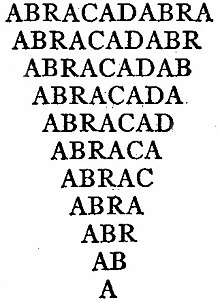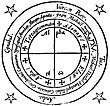Magical formula

| Part of a series on |
| Magic |
|---|
 |
| Part of a series on |
| Thelema |
|---|
 |
In ceremonial magic, a magical formula or a word of power is a word that is believed to have specific supernatural effects.[1] They are words whose meaning illustrates principles and degrees of understanding that are often difficult to relay using other forms of speech or writing. It is a concise means to communicate very abstract information through the medium of a word or phrase.
These words often have no intrinsic meaning in and of themselves. However, when deconstructed, each individual letter may refer to some universal concept found in the system in which the formula appears. Additionally, in grouping certain letters together one is able to display meaningful sequences that are considered to be of value to the spiritual system that utilizes them (e.g., spiritual hierarchies, historiographic data, or psychological stages).
A formula's potency is understood and made usable by the magician only through prolonged meditation on its levels of meaning. Once these have been internalized by the magician, that person can then utilize the formula to maximum effect.[citation needed]
Since most of these permutative arrangements have their origin in Hermetic Qabalah, many of the formulae listed below can be best understood by using various techniques of Hebrew Kabbalah such as gematria (or isopsephy), temurah, and notariqon to analyze them.[citation needed]
Formulae
- Abracadabra. A common incantation used in ancient times as a cure for fevers and inflammations.[2][3][4]
- ABRAHADABRA. This formula was coined by occult writer Aleister Crowley, who described it as "the Word of the Aeon, which signifieth the Great Work accomplished."[5]
- ABRAXAS.[6]
- AGAPE. A Greek word meaning "the highest form of love, charity,"[7] which enumerated in Greek isopsephy equals 93.[8][6]
- AGLA. A noṭariqōn (kabbalistic acronym) for אַתָּה גִּבּוֹר לְעוֹלָם אֲדֹנָי ʾAtā gībōr ləʿōlām ʾĂḏōnāy, "Thou, O Lord, art mighty forever." It is said daily in the Gevurot, the second blessing of the Amidah, the central Jewish prayer.[9]
- ALHIM. This is a transliterated Hebrew spelling of Elohim, a name of God—or "Gods" in this case, since the name is a masculine plural of a feminine noun. According to Crowley, it is a formula best used for consecration, since it "is the breath of benediction, yet so potent that it can give life to clay and light to darkness."[10]
- ARARITA. According to Crowley, "a formula of the Macrocosm potent in certain very lofty operations of the Inmost Light."[11]
- AUMGN. For both symbolic and numerological reasons, Aleister Crowley adapted Aum into a Thelemic magical formula, adding a silent 'g' (as in the word 'gnosis') and a nasal 'n' to the m to form the compound letter 'MGN'; the 'g' makes explicit the silence previously only implied by the terminal 'm' while the 'n' indicates nasal vocalisation connoting the breath of life and together they connote knowledge and generation. Om appears in this extended form throughout Crowley's magical and philosophical writings, notably appearing in his Gnostic Mass.[12] Crowley discusses its symbolism briefly in section F of "Liber Samekh",[5] and in detail in chapter 7 of Magick (Book 4).[13]
- BABALON. A goddess in Thelema, whose name means "Gate of the Great God ON" according to Liber Samekh.[5]
- HRILIU. used in Liber XV, The Gnostic Mass.[12][better source needed]
- IAO. Isis – Apophis – Osiris.[14]
- IHVH. See YHVH.
- INRI. Hebrew: ינרי Yod, Nun, Resh, Yod. Hebrew translation of the Christian Jesus, King of the Jews formula,[15] This magical formula represents the passing of life to death and Resurrection, Used in many rituals including the Rose Cross and the Lesser Ritual of the Hexagram by both O.T.O, A∴A∴, and the Hermetic Order of the Golden Dawn.[16]
- IPSOS. the word of the Aeon of Ma'at, other spellings include IPSOSh, IPShOS, and IPShOSh from Liber Pennae Praenumbra by Nema.[17]
- JAHBULON. According to Francis X. King in The Secret Rituals of the O.T.O., the word is used in two rituals of Ordo Templi Orientis: the Lodge of Perfection, in which the candidate receives the Fourth Degree (which is called Perfect Magician and Companion of the Holy Royal Arch of Enoch); and the Perfect Initiate (or Prince of Jerusalem) degree, which falls between the fourth and fifth degrees. King prints in his book the lyrics of a song that contains the word "Jahbulon."[18]
- LAShTAL.[citation needed]
- LVX. Lit.= Latin word; Lux, or light. Part of the formula of the "analysis of the key word" used in the Adeptus Minor ritual of the Hermetic Order of the Golden Dawn, in which it is described in a ritualized manner,[16] linking each letter with an Egyptian Godform. Perhaps most popularized amongst the occult community at large by being included as the opening part to the Lesser Banishing Ritual of the Hexagram in Donald Michael Kraig's 1989 book, Modern Magick.[19]
- MEITHRAS.[6]
- NOX. According to Crowley, "It is explained that this triad lives in Night, the Night of Pan, which is mystically called N.O.X., and this O is identified with the O in this word. N is the Tarot symbol, Death; and the X or Cross is the sign of the Phallus. NOX adds to 210, which symbolizes the reduction of duality to unity, and thence to negativity, and is thus a hieroglyph of the Great Work."[20]
- ON. Looks like the Hebrew name for Heliopolis, from an original meaning "pillar" or "pillars". This city claimed to hold the Primeval Mound where Atum (sometimes identified with the mound) created the world.[21] By Crowley's numeration, ON equals the Hebrew word Samekh (a prop or support), which also serves as the name of a Hebrew letter.[22]
- THELEMA. Per Crowley, "Th - Babalon and the Beast conjoined; e - unto Nuit; L - the Work accomplished in Justice; E - the Holy Graal; M - the Water therein; a - the Babe in the Egg (Harpocrates on the Lotus)."[6]
- VIAOV. Thelemic variation of IAO whose enumeration using gematria equals 93.[23]
- VITRIOL. Visita Interiora Terrae Rectificando Invenies Occultem Lapidem ('Visit the interior parts of the earth: by rectification thou shalt find the hidden stone').[24] Ancient alchemical formula:[11] Sulfuric acid was called "oil of vitriol" by medieval European alchemists because it was prepared by roasting "green vitriol" (iron(II) sulfate) in an iron retort. The first vague allusions to it appear in the works of Vincent of Beauvais, in the Compositum de Compositis ascribed to Saint Albertus Magnus, and in pseudo-Geber's Summa perfectionis (all thirteenth century AD).[25]
- XNOUBIS.[6]
- YHVH. The formula Tetragrammaton refers to the four-letter Hebrew name of God, Jehovah, or Yod, Heh, Vav, Heh (יהוה). These letters have been attributed to numerous four-part symbols, including the classic elements, cardinal directions, Tarot suits, and so on. The formula is often represented by the Father (Yod) joining with the Mother (Heh), to produce the Son (Vav) and the Daughter (Heh). Within Yoga it is possible to see this formula as describing the union of the subject and the object to produce the exalted state of mind and the resulting ecstasy.[26]
- YHShVH, also known as the Pentagrammaton.[citation needed]
See also
- Barbarous name – Meaningless word used in magic rituals
- Ceremonial magic – Variety of rituals of magic
- English Qaballa – English Qaballa system of James Lees
- Enochian – Angelic language
- Great Work – Mystical path developed by occultist Aleister Crowley
- Mantra – Sacred utterance or sound used in meditation, often repeated
- Monas Hieroglyphica – 1564 book by John Dee about an esoteric symbol
- Renaissance magic – Magical science during the Renaissance
- Secret mantra – Indian Buddhist tantric tradition
- Sorcery (goetia) – Magical practice involving evocation of spirits
- Spell – Formula intended to trigger a magical effect
- True name – Name of a thing or being that expresses its true nature
References
Citations
- ^ Lecouteux (2015), p. [page needed].
- ^ Sammonicus (1786), p. 4.
- ^ Shah (2010).
- ^ Chisholm (1911).
- ^ a b c Crowley (1997), "Liber Samekh".
- ^ a b c d e Crowley (1997), p. 169.
- ^ Liddell & Scott (2010), p. 4.
- ^ Skinner (1996), p. 79.
- ^ Mesler (2019), p. 88.
- ^ Crowley (1997), p. 155.
- ^ a b Crowley (1997), p. 168.
- ^ a b Crowley (2016).
- ^ Crowley (1997), pp. 170–73.
- ^ Crowley (1997), pp. 158–165.
- ^ Crowley (1986), pp. 16–23.
- ^ a b Regardie (1971), v. III, p. 308.
- ^ Nema (1995), p. 107.
- ^ King (1973), p. [page needed].
- ^ Kraig (1989), p. 168.
- ^ Crowley (1980), pp. 12–13.
- ^ Utterance 600 in the Pyramid Texts, quoted at http://www.philae.nu/akhet/NetjeruA.html#Atum Archived 2008-12-20 at the Wayback Machine retrieved November 9, 2006
- ^ Crowley (1986), Sepher Sephiroth, entry for 120.
- ^ Crowley (1997), Pt. III, ch. 5.
- ^ Crowley (1974), p. 104.
- ^ Karpenko & Norris (2002), pp. 1002–1004.
- ^ Crowley, Eight Lectures on Yoga, "First Lecture"
Works cited
- Chisholm, Hugh, ed. (1911). . Encyclopædia Britannica (11th ed.). Cambridge University Press.
- Crowley, Aleister (1974). Book of Thoth: (Egyptian Tarot). Red Wheel Weiser. ISBN 978-0877282686.
- Crowley, Aleister (1980). The Book of Lies. ISBN 978-0-87728-516-8.
- Crowley, Aleister (1986). 777 And Other Qabalistic Writings of Aleister Crowley. Weiser Books. ISBN 978-0877286707.
- Crowley, Aleister (1997). Magick: Liber ABA, Book 4, Parts I-IV (Second revised ed.). Boston: Weiser. ISBN 0877289190.
- Crowley, Aleister (2016). Liber XV : Ecclesiae Gnosticae Catholicae Canon Missae. Gothenburg. ISBN 978-8393928453.
{{cite book}}: CS1 maint: location missing publisher (link) - Karpenko, Vladimír; Norris, John A. (2002). "Vitriol in the History of Chemistry". Chemické listy. 96 (12): 997–1005.
- King, Francis, ed. (1973). The Secret Rituals of the O.T.O (1st ed.). Samuel Weiser. ISBN 0877281440.
- Kraig, Donald Michael (1989). Modern Magick: Eleven Lessons in the High Magickal Arts. Llewellyn Worldwide. ISBN 0-87542-324-8.
- Lecouteux, C. (2015). Dictionary of Ancient Magic Words and Spells: From Abraxas to Zoar. Inner Traditions/Bear. ISBN 978-1-62055-375-6.
- Liddell, H. G.; Scott, Robert (2010). An Intermediate Greek-English Lexicon: Founded Upon the Seventh Edition of Liddell and Scott's Greek-English Lexicon. Benediction Classics. ISBN 978-1-84902-626-0.
- Lycourinos, Damon (2017). "Sexuality, Magic(k) and the Ritual Body: A Phenomenology of Embodiment and Participation in a Modern Magical Ritual". Journal of Ritual Studies. 31 (2): 61–77. JSTOR 44988498.
- Mesler, Katelyn (2019). "The Latin Encounter with Hebrew Magic". In Page, Sophie; Rider, Catherine (eds.). The Routledge History of Medieval Magic. London: Routledge, Taylor & Francis Group.
- Nema (1995). Maat Magic: a Guide to Self-Initiation. York Beach, ME: Samuel Weiser. ISBN 0-87728-827-5.
- Regardie, Israel (1971). The Golden Dawn: The Original Account of the Teachings, Rites and Ceremonies of the Hermetic Order of. Llewellyn Worldwide. ISBN 0-87542-664-6.
- Sammonicus, Quintus Serenus (1786). Quinti Sereni Samonici De medicina praecepta salvberrima. In bibliopolio I.G. Mülleriano.
- Shah, Sonia (10 July 2010). "The Tenacious Buzz of Malaria". Wall Street Journal. Retrieved 17 June 2018.
- Skinner, Stephen, ed. (1996). The Magical Diaries of Aleister Crowley: Tunisia 1923. Samuel Weiser. ISBN 0-87728-856-9.
Other sources
- Thelemapedia. (2003). Magical Formulae. Retrieved May 14, 2006.
Further reading
- Conley, Craig (2008). Magic Words: A Dictionary. Weiser Books. ISBN 978-1609250508.
